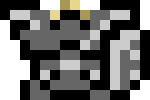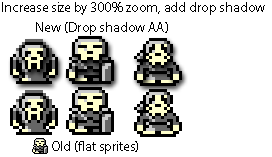I imagine it’s customary to declare something in your first post, even on a blog meant to be a temporary home for your URL. Well, I won’t be one to break this apocryphal assertion!
Allow me to introduce you to a pet project with which I hope to take up a bit of my time between now, and my hopeful entry to graduate school. This should read primarily as a PSD for my venture I’d like to call:
Jötunheimr: Tales of Dwarf Fortress
What Is “Dwarf Fortress”?
Simply put, it’s an ASCII-Roguelike Management Sim. You start with 7 little Dwarfs, and through indirect guidance you build your own little kingdom. There is no victory condition – which naturally means that there are infinite loss conditions. But, that’s part of the fun!
I spent a good month or so of my free time sophomore year of college teaching myself how to play Dwarf Fortress. Besides the High Fantasy setting of the narrative and the beauty of its procedural generation, I was awestruck at just how easy it was to modify the raw files. User generated content is part of Dwarf Fortress’ underground success story, so much so that it’s creator, Tarn Adams, admits that the modders often know more about the raws than he himself does. Which is where this venture comes in…
So, What Is “Jötunheimr”, Then?
I’ve always enjoyed Norwegian and Scandinavian involving Giants and Trolls, much as I enjoy stories about Dwarfs. Trolls and Giants exist as kind of a antithesis to Dwarfs, however. Where Dwarfs are industrious, secluded and traditional, Giants and Trolls are malicious, wandering plunderers. At least, many of them were. Accounts vary from source to source, which is why I’m differentiating “Giants” and “Trolls” in the first place.
The name Jötunheimr breaks down roughly into the place where most Giants were forcefully banished or forced to by the Æsir – the Nordic Pantheon, headed by Odin or Woden or Woten… you get the picture.
In keeping with the spirit of Dwarf Fortress, however, I will not be touching the magical High Fantasy where the Æsir are often portrayed. Instead, I will be focusing on the day to day life and survival of…
The Jötun
I’ve been skipping back and forth between Jötun, Giant, Troll for a bit now, which is – etymologically speaking – pointless. The images they invoke, are of course, different, but they are functionally the same creatures in the regional folklore. Personally, I prefer Troll – the term helps differentiate the creatures from similar beings worldwide. The Japanese Oni, the Irish Fomorian or Fir Bolg, and the Hungarian Guta to name only a fraction of these wild, often bloodthirsty, usually towering “proto-Human” or demonic beings. Also, Troll doesn’t include umlauts.
For this project, the Trollkin that will be featured will be as varied as they are represented in myth. Indeed, Trolls can range from cat-size, to actual mountains (when reclining!). Of course, mountain-size and multi-tile creatures are a bit out of reach in Dwarf Fortress’ current release, so I will content myself with merely enormous for the time being. The most important part of my design will to represent “Trollkin” as a culture, rather than a physical description.
The Heimr
I spent a bit going over how Trollkin are a bit of chaotic species, so how do I go about justifying the main point of Dwarf Fortress – namely, survival through planning and micromanagement. I’d like to point out that Trolls, while generally brutish and uncooperative, aren’t all as dumb as our general perception leads us to believe. Some were noted as very old and wise, for example, the character Mimir, who gave Odin knowledge of magic and runes (writing), is often portrayed as a Jötun.
This isn’t to say that it is easy to organize Trollkin, for even the intelligent and wise ones lead solitary existences in tales. Part of the successful implementation of “Jötunheimr: Tales of Dwarf Fortress” would to be the functional implementation of a primal, disorganized settlement. Where Dwarf Fortress welcome and rewards order and planning, “Jötunheimr” should frown on this behavior, and while not outright condemning it, there should be gameplay reasons to embrace a sort of “functioning entropy”.
My initial plans to implement this gameplay mechanic lies in the Trollkin themselves. Since you get 7 starting settlers, there should be enough variance in the Troll race so as to make those 7 Trolls as different and useful as possible. Emphasis on the useful – we’re not talking small, communal Dwarfs or average, mundane Humans here – Trolls are resilient, sturdy creatures, and even the weakest among them achieved great acts of physical power and fortitude before their coming of age year. Their strength comes from the nature world and its primal forces, and they embody aspects of the world around them. Mountain Trolls have tough, craggy bodies, and are capable of mitigating strikes that would cut lesser creatures to pieces. Forest trolls have skin and bodies not unlike the deep woods in which they dwell, allowing them to continuously grow and regenerate hewn limbs effortlessly. In contrast, River Trolls are natural sneaks, adept at concealment under bridges, for example. They are natural swimmers, and extremely dangerous in their natural habitat.
Every Troll, An Island
One thing that unites all Trollkin is their unending life spans, and immense ability to survive even the most mortal of wounds. Unlike the Dwarfs in Dwarf Fortress, Trolls are enduring creatures, who are able to take on small armies alone, carry bone-crushing loads, survive on nearly no food. Of course, they are not without flaws, and each one of these comes with terrible drawbacks – both in gameplay and my own modification process.
Trolls are nearly always portrayed as great gluttons – and while this is a benefit in that they are by no means picky when it comes to dinner, they eat as continuously as Dwarfs drink. Their diet extends to mushrooms and plants, much like Dwarfs, but they prize meat and bones above all. They move and work more quickly and happily with full bellies, which leads to obvious problems should their food supply be less than amble.
Regeneration is a cornerstone of Trollkin mythology, and while the Dwarf Fortress engine allows for the regrowth of lost limbs, it is by no means elegant. To dip into coding speak, there must be a “workshop” which has a reaction that will allow a entity to completely regrow a severed body part. This will take some work to make it feel authentic and not simply a Arm-Regrowing-Station.
Finally, the physical strength of each individual Troll is a bit of a sticky point. Would it be better to never tire, or to effortlessly lift any load? The latter has the drawback that a entity with that amount of strength would be able to literally blow apart any opposition with a flick of their Superman-like pinky finger – not the most balanced mechanic, and also leads to very boring stories.
The First Step
So begins my little pet project. I hope to post again soon, either with pseudo-code or some artistic renditions of my Trollkin concept. At any rate – Stay Tuned!
-Sándor Csontos




